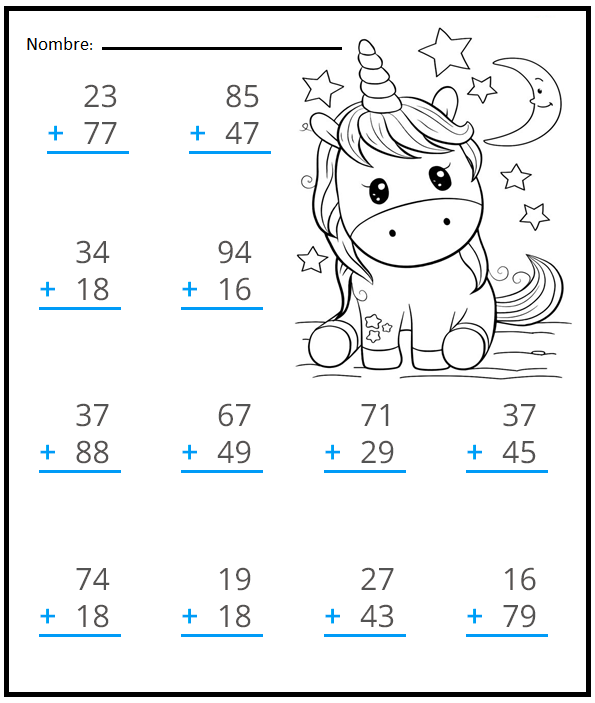Mastering Double-Digit Addition with Carry-Over: Visual Aids and Techniques
Struggling with adding numbers like 45 + 27? The concept of "carrying over" can be tricky for beginners in arithmetic. This guide dives into the world of double-digit addition with carry-over (equivalent to the Spanish term "imagenes de sumas llevando de dos cifras"), exploring visual methods, practical exercises, and problem-solving strategies to build a strong foundation in mathematics.
Imagine having to add 27 toys to your existing collection of 45. You can't just combine the 2 and the 4, and the 7 and the 5. That's where carrying over comes in. It's a fundamental concept in addition where the value of the sum of digits in one place value column is ten or greater. Part of the sum is then "carried over" to the next higher place value column. This seemingly simple operation is crucial for more complex calculations later on.
The historical development of carrying over in addition is tied to the evolution of place-value systems. Ancient civilizations used various methods, but the modern system, based on Hindu-Arabic numerals, revolutionized arithmetic. Carrying over simplified calculations and made it possible to efficiently handle larger numbers. It’s a cornerstone of basic arithmetic operations taught across the globe.
The core issue with "imagenes de sumas llevando de dos cifras" (images of double-digit addition with carry-over) is ensuring a clear understanding of the underlying process. Visual aids are essential. Think of adding 38 and 15. When you add 8 and 5, you get 13. The '1' in '13' represents ten units, so it's carried over to the tens column, adding to the 3 and 1 already there. This can be visualized using blocks, beads, or even drawings.
For beginners, visualizing the addition process is crucial. Imagine two boxes labeled "Tens" and "Ones." When adding 38 and 15, you put 3 tens blocks and 8 ones blocks in their respective boxes, then add 1 ten block and 5 ones blocks. Combining the ones results in 13 ones blocks. Since ten ones make one ten, you exchange ten ones blocks for one ten block and move it to the "Tens" box. This leaves 3 ones blocks. Now, the "Tens" box has 3 + 1 + 1 = 5 ten blocks. The final answer is 53, represented by 5 tens and 3 ones.
Benefit 1: Foundation for complex math: Mastering double-digit addition with carry-over sets the stage for multiplication, division, and other advanced arithmetic operations.
Benefit 2: Real-world application: From calculating grocery bills to managing finances, this skill is used daily.
Benefit 3: Improved problem-solving skills: Carrying over enhances logical thinking and systematic problem-solving abilities.
Action Plan: Start with single-digit addition, then progress to adding two-digit numbers without carrying over. Finally, introduce carrying over with visual aids and progressively more complex examples.
FAQs:
1. Why is carrying over important? It allows for adding numbers larger than 9 in each place value.
2. What if I forget to carry over? The answer will be incorrect, usually lower than the actual sum.
3. How can I practice? Use worksheets, online games, or real-world scenarios.
4. What are some common mistakes? Forgetting to add the carried-over digit is a common error.
5. Can I use my fingers? Initially, yes, but the goal is to perform the calculation mentally.
6. What are other visual aids besides blocks? Number lines, charts, and even drawings can help.
7. How do I explain carrying over to a child? Use simple language and relatable examples, like toys or candies.
8. How can I make learning fun? Incorporate games, challenges, and rewards.
Tips & Tricks: Practice regularly with varied examples. Use visual aids to reinforce understanding. Break down the process into smaller, manageable steps. Celebrate small successes to build confidence.
In conclusion, mastering double-digit addition with carrying over, or "imagenes de sumas llevando de dos cifras" as it's sometimes referred to, is a fundamental skill in mathematics. From everyday tasks to complex calculations, this skill is essential. Utilizing visual aids, practicing regularly, and understanding the underlying principles are key to success. By embracing these techniques and understanding the importance of carrying over, learners build a strong foundation for future mathematical endeavors. So, grab a pencil, some paper, and perhaps a few colorful blocks, and embark on the journey of mastering this crucial skill. The power of numbers awaits!
Unveiling johnnie walker black label whisky prices in hyderabad
Cecil county public schools operating status
Exploring the once saved always saved doctrine














